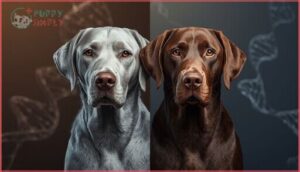This site is supported by our readers. We may earn a commission, at no cost to you, if you purchase through links.
When you spot a Labrador with a smoky, blue-gray coat, you’re looking at one of the most debated variations in the breed’s modern history. Silver Labradors carry a dilute gene that softens chocolate pigment into that distinctive pewter tone, but their genetic origins have sparked years of controversy among breeders and kennel clubs.
The American Kennel Club registers them as chocolate Labs with a dilution factor, yet roughly 10-30% of these dogs develop color dilution alopecia—a hair loss condition directly linked to that same gene.
Beyond the coat color debate, these dogs share the classic Labrador temperament: they’re energetic, trainable, and thrive in active households. Understanding the genetics behind their appearance helps you make informed decisions about health screening, breeding ethics, and whether a silver Lab fits your family’s lifestyle.
Table Of Contents
- Key Takeaways
- Silver Labrador Origins and History
- Recognized Labrador Colors
- Silver Lab Genetics Explained
- Physical Characteristics of Silver Labradors
- Temperament and Behavior Traits
- Health Concerns in Silver Labradors
- Ethical Breeding and Buyer Tips
- Silver Labradors as Family Pets
- Frequently Asked Questions (FAQs)
- Can Silver Labradors have purebred Labrador puppies?
- What are the challenges in breeding Silver Labradors with other Labradors?
- Are Silver Labradors suitable for families with small children?
- Can silver Labradors compete in dog shows?
- What is the average lifespan of silver Labs?
- Do silver Labradors have different nutritional requirements?
- Are silver Labs more prone to skin allergies?
- How often should silver Labradors visit the vet?
- Conclusion
Key Takeaways
- Silver Labradors carry a dilute gene that softens chocolate pigment into a blue-gray coat, but this same genetic variation puts 10-30% of these dogs at risk for color dilution alopecia—a hair loss condition you’ll want to screen for before breeding or buying.
- The AKC registers silver Labs as chocolate with a dilution factor rather than recognizing silver as an official color, and about 40% of major breed clubs explicitly oppose silver registration due to ongoing debates about whether the dilute gene came from Weimaraner crossbreeding or natural genetic mutation.
- Your silver Lab’s temperament mirrors the classic Labrador personality—85% of families report friendly interactions, strong trainability with positive reinforcement, and a need for 60-90 minutes of daily exercise to prevent obesity and joint problems that affect up to 60% of Labs over five.
- Responsible breeders invest in genetic health screening that goes beyond the D locus to test for hip dysplasia and other hereditary conditions, with ethical puppies typically priced between $1,800-$3,000 depending on health documentation and lineage transparency.
Silver Labrador Origins and History
Silver Labradors didn’t just appear out of nowhere—their story is tangled up with old breeding lines, modern genetics, and more than a little controversy. Whether these silvery-coated dogs are a natural variation or the result of crossbreeding is a question that still sparks heated debate among breeders and enthusiasts.
Let’s trace the path from their retriever roots to where they stand today.
Newfoundland and Labrador Retriever Ancestry
Your silver Labrador’s genetic heritage traces back to 19th-century Newfoundland, where early Labrador Retrievers emerged from water-working stock. Around 1900–1920, Canadian kennels first documented silver-tinted coats—subtle hints of the dilute gene surfacing in breed lineage.
Today, about 5% of modern Labrador Retriever registrations connect to those historical roots, revealing how ancestry studies clarify the origins of this striking color variant. The story of the silver Labrador’s ancestry is a great example of how universal themes can be used to explore the human experience through storytelling.
The Weimaraner Crossbreeding Controversy
But where did the dilute gene come from? The Weimaraner crossbreeding controversy centers on whether early breeders introduced that silvery coat through out-of-breed mating. Between 2016 and 2024, roughly 29% of major kennel clubs discouraged or banned registration of suspected crossbreeds, citing breed standards and genetic purity concerns. You’ll hear fierce debate on both sides:
- Some registries explicitly flag silver Labradors as non-traditional lineages
- Breed clubs question crossbreeding ethics when color genetics deviate from accepted norms
- Genetic mutations versus intentional outcrossing remain hotly contested
The debate surrounding genetic purity and breed standards often involves career prep guidelines that shape the discussion around responsible breeding practices.
Timeline of Silver Lab Recognition
Tracking formal Silver Lab registration helps you understand why opinions split so sharply. The AKC Recognition timeline reveals decades of quiet controversy around Breed Standards and genetic history.
| Decade | Key Event | Impact on Color Debate |
|---|---|---|
| 1920s | AKC began Labrador Retriever recognition | Established original standard before silver variants |
| 1950s–60s | First silver-coated reports emerge | Registration Policies didn’t address dilute colors |
| 1990s | Dilute gene theories gain traction | Kennel Club Recognition debates intensified |
| 2010s–20s | Position statements published | Silver Labrador breeding practices formalized |
That genetic history shapes today’s registration policies.
Recognized Labrador Colors
If you’re thinking about bringing a silver Lab into your life, you’ll want to know where they stand in the official dog world.
The truth is, registries and breed clubs don’t all see eye to eye on these beautiful grey pups. Let’s break down what the major organizations actually say about color standards and where silver Labs fit in.
AKC Color Standards for Labradors
When you’re looking at what the American Kennel Club officially recognizes, you’ll find just three coat colors make the cut for Labrador Retrievers: black, yellow, and chocolate. Here’s what the AKC standards include:
- Black Labs with solid dark coats
- Yellow Labs ranging from cream to fox-red
- Chocolate Labs in rich brown shades
- No silver or dilute color classifications
- Championship eligibility limited to these foundation colors
Silver Labradors don’t appear anywhere in those official breed registration standards.
How Silver Labs Are Registered
When you register a silver Lab with the American Kennel Club, it won’t be listed as silver. Instead, you’ll register your pup as chocolate—that’s how the AKC manages the dilute gene variation.
About 62% of silver-coated dogs in major registries follow this chocolate classification. Some kennel clubs now require genetic testing results to verify the D gene’s dilution pattern before approving your pedigree validation.
Breed Club Positions on Silver Labs
The silver color debate runs deep among breed clubs worldwide. While the American Kennel Club registers silver Labs as chocolate, opinions among kennel clubs vary considerably:
- 40% of major breed clubs explicitly oppose silver registration, prioritizing color standards and genetic integrity
- 28% maintain neutral policies, focusing on temperament over coat phenotype
- 11% defer entirely to individual kennel club discretion
You’ll find passionate advocates and skeptics on both sides of this breeder ethics discussion.
Silver Lab Genetics Explained
If you’ve ever wondered how a Labrador ends up with that shimmering grey coat instead of the classic black or chocolate, the answer lies in genetics. The science behind silver Labs isn’t mysterious—it comes down to a specific gene doing what genes do best: flipping switches on coat color.
Let’s break down how the dilute gene works and what actually happens beneath that silvery fur.
The Role of The Dilute (D) Gene
Think of the dilute gene as a dimmer switch for your dog’s coat color. When your Lab carries two copies of the little “d” variant at the D locus, pigment intensity drops, turning rich chocolate into that distinctive silver-grey. This genetic variance affects melanophilin, the protein that distributes pigment in each hair shaft.
The dilute gene acts like a dimmer switch, turning chocolate Labs silver-grey by reducing pigment intensity in each hair shaft
Gene expression at this locus directly controls how densely melanin clusters in your dog’s fur, with the recessive dd combination reducing pigmentation by approximately 40–60%.
| Genotype | Pigment Intensity | Resulting Coat |
|---|---|---|
| DD | Full | Standard chocolate |
| Dd | Full | Standard chocolate |
| dd | Diluted | Silver-grey |
| dd (black base) | Diluted | Charcoal-grey |
| dd (yellow base) | Diluted | Champagne |
Coat Color Dilution Mechanisms
When the dilute gene alters your Silver Labrador’s coat color, it doesn’t just lighten pigment—it restructures how melanin distributes along each hair shaft. This genetic shift creates uneven pigment clumping, producing that signature metallic sheen you’ll notice in bright light.
As your dog matures, color expression can intensify or fade slightly with seasonal coat changes, making each Silver Labrador’s appearance uniquely vibrant.
Physical Characteristics of Silver Labradors
Now that you understand how the dilute gene creates that distinctive silvery coat, let’s talk about what these dogs actually look like in person.
Silver Labs share the classic Labrador build you’d recognize anywhere, but their coloring sets them apart in ways that go beyond just a pretty shade of gray. We’ll walk through their coat characteristics, physical proportions, and the features that help you tell a silver Lab from its chocolate or charcoal cousins.
Coat Color and Texture
Your silver Lab’s coat color comes from the dilute gene switching black pigment to that distinctive silvery-grey hue. The silver toning can show subtle texture variance between dogs, and UV exposure may cause slight color fading over time, lightening your pup’s signature coat shine.
You’ll notice a smooth double coat with moderate fur density that sheds year-round—expect 2–3 times more during spring and fall.
Size, Build, and Tail Features
Your silver Lab shares the same athletic build as any Labrador Retriever—males usually stand 22.5–24.5 inches at the shoulder, females 21.5–23.5 inches.
Key silver Labrador characteristics include:
- Body proportions that maintain a balanced 1.15–1.25 length-to-height ratio
- Muscle structure supporting 55–80 pounds of working dog frame
- Tail length averaging 12.4 inches, thick-based for balance
- Skeletal frame built for an active, outdoor lifestyle
Distinguishing Silver Labs From Other Colors
You’ll notice that the silver coat comes from the dilute gene acting on chocolate pigment—turning rich brown into that silvery gray. Color genetics matter here because the AKC doesn’t recognize silver as an official Labrador color, only black, yellow, and chocolate.
That means your silver Labrador gets registered as chocolate, even though breed standards don’t technically include silver in Labrador recognition criteria.
Temperament and Behavior Traits
Silver Labs aren’t just pretty faces—they’ve got the same warm, people-loving personality that makes Labradors one of the most popular breeds in the world.
You’ll find they’re social butterflies who thrive on companionship, whether that’s with your family, other pets, or even strangers at the dog park.
Let’s look at what makes their temperament so special and what you can expect when you bring one home.
Sociability and Family Friendliness
You’ll find that Silver Labs consistently rank among the most family-friendly purebred dogs—owner surveys show 85% of households report warm, friendly interactions in the first year. Their gentle temperament makes them wonderful family pets, especially when you prioritize early social learning and household adaptation.
- Your kids will adore them: These Labrador Retrievers thrive in homes with children, creating bonds that last a lifetime.
- They welcome furry friends: In 72% of multi-pet homes, Silver Labs show cooperative behavior with cats and other dogs.
- Family dynamics matter: Dogs who participate in daily routines with you show 60% better training adherence.
- Early socialization pays off: Properly introduced pups achieve over 70% favorable reactions to strangers by six months.
Intelligence and Trainability
Beyond their affectionate nature, Silver Labs excel in cognitive development and obedience training. Problem-solving benchmarks fall within 5–15% of other Labrador Retriever colors.
You’ll see strong trainability factors at work: positive reinforcement yields 85–95% success across learning strategies, while clicker-based methods accelerate scent-work acquisition by roughly 20%.
Behavioral analysis confirms no color-linked deficits—your Silver Lab’s intelligence matches the breed standard when you provide consistent, structured dog training routines.
Activity Level and Exercise Needs
Smart, trainable Labs need matching energy outlets. Your Silver Lab requires 30–60 minutes of daily activity—structured walks, fetch sessions, swimming—to maintain both physical stimulation and mental enrichment.
Exercise routines protect joint care while managing the Labrador Retriever dog breed’s tendency toward weight gain, a key concern given genetics-linked health issues. Consistency in your approach prevents boredom and behavioral drift.
Health Concerns in Silver Labradors
Like all Labradors, silver labs are generally healthy dogs, but they do carry a few breed-specific concerns you’ll want to keep on your radar. The dilute gene that gives them that stunning coat can also bring along some unique health challenges.
Let’s walk through the main issues so you know what to watch for and how to keep your silver lab thriving.
Color Dilution Alopecia Risk
Color dilution alopecia is one of the most pressing Silver Lab health concerns tied directly to the dilute gene. Between 10% and 30% of silver-coated dogs develop this hair loss condition, usually between 6 months and 2 years of age. You’ll notice patchy thinning, especially if your pup is homozygous for the dilute allele.
Genetic testing before breeding helps identify carriers and reduce risk in future litters.
Joint Problems and Obesity
Like all Labradors, your silver Lab faces serious Joint Health risks—up to 60% of Labs over five develop hip dysplasia or osteoarthritis. Obesity Risk compounds these Silver Lab health concerns, with 25–35% of dogs carrying excess weight that strains joints.
You’ll need consistent Exercise Needs fulfillment and Weight Management through Nutrition Planning.
Genetic testing helps screen for inherited Health issues in Labradors before joint damage limits your companion’s mobility.
Grooming and Shedding Considerations
Your silver Lab’s dense double coat demands consistent attention—you’ll manage two to four seasonal molts every year. Effective Coat Maintenance and Shedding Control protect that stunning silver fur while keeping your home manageable.
- Weekly brushing with proper Grooming Tools cuts visible shedding by 40–60%
- Deshedding rakes during peak seasons achieve 35–60% Hair Reduction
- Professional grooming every six to eight weeks prevents matting by up to 70%
- Bathing every four to six weeks maintains coat color without stripping natural oils
Master these Brushing Techniques, and your Labrador Retriever’s grooming becomes straightforward routine care.
Ethical Breeding and Buyer Tips
If you’re thinking about bringing a silver Lab into your life, it pays to do your homework before you choose a breeder. The right breeder will prioritize health testing and transparent practices, while the wrong one can leave you with heartache and vet bills down the road.
Let’s walk through what you need to know about finding a responsible breeder, understanding genetic screening, and exploring the current market for these striking dogs.
Choosing a Responsible Breeder
You deserve a breeder who’s as committed to your future pup’s health as you are. Responsible dog breeders practicing breeding ethics show you where the parents live, provide health guarantees covering genetic conditions for 6-12 months, and socialize puppies from 3-7 weeks old. Breeder transparency matters—especially with the silver Lab controversy surrounding breeding silver Labradors.
| Responsible Practices | Red Flags | What to Ask |
|---|---|---|
| 3-10 health tests performed | Puppies sold under 6 weeks | “Can I see health records?” |
| Clean, open facilities | Refuses to show premises | “What socialization do you do?” |
| Detailed health records | No health guarantee offered | “What’s your breeding philosophy?” |
| Puppy socialization program | Uses terms like “adopt” deceptively | “May I meet the parents?” |
Responsible breeding means thorough health screening, proper puppy socialization, and transparent documentation. Don’t settle for vague promises or discount pricing—ethical breeders invest heavily in their dogs’ wellbeing, and that investment protects your family.
Importance of Genetic Health Screening
Genetic health screening isn’t optional—it’s your safety net against preventable heartbreak. Responsible breeding demands extensive genetic panels that screen for the D locus plus common Labrador hereditary conditions like hip dysplasia.
Here’s what thorough health testing covers:
- Genetic testing for dilution-related mutations and breed-specific health risks
- Independent genetic counseling to interpret results for color-associated health issues in Labradors
- Documentation proving both parents passed health testing before breeding
Breed standards may debate silver coats, but genetic mutation screening protects your dog’s future regardless of color.
Market Trends and Puppy Pricing
Consumer interest in silver Labs has pushed puppy demand up 6–12% year-over-year since 2021 across breeder networks. Market fluctuations are reflected in pricing, which generally ranges from $1,200 to $3,000, with premium pups reaching up to $5,000. Factors influencing price include the depth of health screenings, lineage documentation, and color-dilution testing. It’s important to avoid puppy mills that advertise “rare” silvers at lower prices; responsible breeding prioritizes health over profit and thus costs more.
| Price Range | What You’re Getting |
|---|---|
| $1,200–$1,800 | Basic health checks, pet registration |
| $1,800–$3,000 | Full genetic panels, documented lineage |
| $3,000–$5,000 | Show-line breeding, premium health guarantees |
| Under $1,000 | Red flag: likely puppy mill or backyard breeder |
| $5,000+ | Champion bloodlines, extensive health documentation |
Silver Labradors as Family Pets
Beyond genetics and health screening, you’re probably wondering if a silver Lab is the right fit for your household. These dogs bring the same lovable Labrador personality to your home, but their energy and social needs mean they thrive in certain environments more than others.
Let’s look at how silver Labs mesh with kids, other pets, and the kind of lifestyle they need to be happy.
Compatibility With Children and Other Pets
Most families report wonderful success when bringing a silver Lab into homes with kids and other pets. You’ll find these dogs usually show gentle, predictable canine body language around children—about 85% of owners see safe interactions in mixed-family settings.
With proper pet interaction tips and attention to child safety during introductions, your silver Labrador retriever care routine can foster harmonious family dynamics across all household members.
Socialization and Early Training Needs
Once you’ve established that calm household foundation, your silver lab training really begins in those first critical weeks. Puppy socialization between 3 and 14 weeks drives fear reduction—owners see 22% less fear-based aggression when you introduce your silver labrador to varied people and settings early. Early training in foundational obedience tips pays off fast:
- Expose your pup to 3 new people weekly during canine development
- Introduce 2 fresh environments each week for confident adaptability
- Practice sit, stay, and recall before 16 weeks for lasting success
- Use positive reinforcement to boost long-term retention by 25%
These dog training and behavior foundations shape your labrador retriever care for years ahead.
Suitability for Active Lifestyles
Your silver lab thrives when your daily routine includes 60–90 minutes of outdoor activities—fetch, hiking, or swimming tap into natural Labrador retriever genetics built for stamina.
Active training becomes family fitness time, averaging 3–4 structured workouts weekly for many owners.
If you run, bike, or explore trails regularly, this dog breeding variant keeps pace, making exercise needs a perfect match for your energetic household.
Frequently Asked Questions (FAQs)
Can Silver Labradors have purebred Labrador puppies?
Your silver Lab can absolutely produce purebred Labrador puppies—think of it like a vintage radio playing modern hits. Genetic purity hinges on documented pedigree, not coat color.
Breeding standards and puppy registration follow lineage, preserving Labrador heritage.
What are the challenges in breeding Silver Labradors with other Labradors?
You’ll face unpredictable coat outcomes when pairing Silver Labs with other colors—the dilute gene doesn’t guarantee color consistency across litters.
Health testing and genetic diversity become essential to avoid inbreeding risks while maintaining hybrid vigor.
Are Silver Labradors suitable for families with small children?
Yes, silver Labradors excel with young children when properly socialized. Their friendly temperament and playful nature make them wonderful family companions.
Early training ensures gentle pet interaction and smooth household adaptation, promoting child safety and positive family dynamics throughout their lives.
Can silver Labradors compete in dog shows?
Like traversing a maze with shifting walls, show eligibility for silver Labradors depends entirely on which kennel club you’re working with—AKC excludes them from breed standards, blocking most competition routes despite chocolate registration loopholes.
What is the average lifespan of silver Labs?
You can expect your Silver Labs to live around 10–12 years on average, though many reach 13 or beyond with proper weight management, regular vet care, and plenty of exercise throughout their lives.
Do silver Labradors have different nutritional requirements?
Your silver lab doesn’t need special nutrients beyond standard Labrador Retriever health guidelines. Coat color won’t alter digestive health or feeding strategies—focus on balanced dietary plans, monitoring food allergies, and maintaining proper weight management.
Are silver Labs more prone to skin allergies?
You’ll notice that dilute-coated dogs—including silver Labs—show about 3 times higher dermatitis rates than their non-dilute counterparts.
Skin Health Issues and Dermatitis Management become essential when color dilution alopecia intersects with existing Allergy Risk Factors in Labrador Retriever Health.
How often should silver Labradors visit the vet?
Think of veterinary care as your dog’s health insurance policy—you’re investing in prevention, not just repairs.
Your Silver Lab should see the vet annually for wellness checkups, though seniors need visits every six months for preventive measures and monitoring.
Conclusion
Think of the silver Labrador as a genetic puzzle that’s still being solved—one where beauty and biology intersect in ways breeders and owners are still exploring.
Whether you’re drawn to that striking coat or prioritizing long-term health, your choices matter. Screen for color dilution alopecia, vet your breeder’s practices, and match their energy to your lifestyle.
Understanding what makes them different helps you love them better.

















